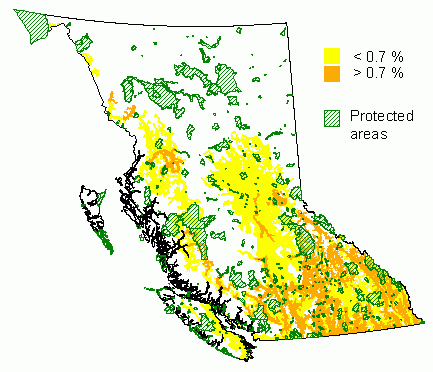Rocky Mountain maple
Acer glabrum Torr
Introduction
Rocky Mountain maple is a small, often multi-stemmed tree. It grows on wetlands, stream banks and slopes. The species covers a wide range of moisture levels, is moderately shade tolerant, and grows at elevations of 350 to 1,450 m. It grows in the understory of coniferous forests, in mixed shrub communities, and, at high elevations, mixed with deciduous trees. As a prolific sprouter, it rapidly reclaims disturbed sites such as avalanche paths. Rocky Mountain maple is an important tree for wildlife. A variety of animals feed on the leaves, buds, twigs and seeds. It also provides good shelter for many animals. Because of its tolerance to drought and its ability to sprout, it is used as an ornamental and for stabilizing roadsides and riverbanks (Anderson 2001). The first peoples used its tough, pliable wood in a variety of ways. The bark was used for making rope and the wood is an excellent fuel (Turner 1979).
Rocky Mountain maple occurs from Alaska to California on the Pacific coast, and further south to Arizona and New Mexico in the Cordilleran mountains. More than half of the range is located outside of British Columbia (Little 1976).
Distribution and Protected Areas – from Hamann et.al. 2005

Conservation Status Summary – from Chourmouzis et.al. 2009
No in situ conservation concerns were identified for this species.
Reproduction
Rocky Mountain maple is resilient to many disturbances because it can readily sprout from stumps after damage. Yet, sexual regeneration of this species may be difficult. Large seed crops only occur every one to three years (Olson and Gabriel 1974; Haeussler et al. 1990; Banerjee et al. 2001), and seeds may lose their viability quickly during dry, frosty periods. Haeussler et al. (1990) and Stathers et al. (1990) state that seeds stored on-site play an important role in regeneration. If so, such seed would provide a buffer for local populations against drastic changes. However, Steele and Geier-Hayes (1995) disagree that such stored seed would account for much of the regeneration.
Genetic structure
Because of its wide range, the species is likely to show substantial regional genetic differentiation. Although there are no genetic studies available, this is reflected in the fact that six taxonomic varieties have been recognized rangewide (Anderson 2001).
Resource management and seed transfer
No information available.
REFERENCES
Hamann, A., Smets, P., Aitken, S. N. and Yanchuk, A. D. 2005. An ecogeographic framework for in situ conservation of forest trees in British Columbia. Can. J. For. Res. 35:2553-2561. View online resources for this report.
C. Chourmouzis, A.D. Yanchuk, A. Hamann, P. Smets, and S.N. Aitken. 2009. Forest Tree Genetic Conservation Status Report 1: In situ conservation status of all indigenous BC species. Centre for Forest Conservation Genetics, Forest Genetics Council of BC, and BC Ministry of Forests and Range, Forest Science Program, Victoria, BC Technical Report 053. www.for.gov.bc.ca/hfd/pubs/Docs/Tr/Tr053.htm
Anderson, M. D. 2001. Acer glabrum. U.S. Department of Agriculture, Forest Service, Rocky Mountain Research Station, Fire Sciences Laboratory (2002, January). Fire Effects Information System, [Online]. Available: http://www.fs.fed.us/database/feis/ [February 2002].
Banerjee, S. M., Creasy, K. and Gertzen, D. D. 2001. Native woody plant seed collection guide for British Columbia. Crown Publications, Victoria. 147 p.
Haeussler, S., Coates, D., Mather, J. 1990. Autecology of common plants in British Columbia : a literature review. FRDA report 158. Forestry Canada, Victoria, B.C. 272 p.
Little, E. L. Jr. 1976. Atlas of United States trees, volume 3, minor western hardwoods. U.S. Department of Agriculture Miscellaneous Publication 1314. 13 p., 290 maps.
Olson, D. F. Jr. and Gabriel, W. J. 1974. Acer L., maple. In: C. S. Schopmeyer (technical coordinator). Seeds of woody plants in the United States. Agriculture Handbook 450. U.S. Department of Agriculture, Washington. 883 p.
Stathers, R. J., Trowbridge, R., Spittlehouse, D. L. and others. 1990. Ecological principles: basic concepts. p. 45-54 in: Lavender D.P. et al. (Eds.), Regenerating British Columbia’s forests. University of British Columbia Press, Vancouver.
Steele, R. and Geier-Hayes, K. 1995. Major Douglas-fir habitat types of central Idaho: a summary of succession and management . Gen. Tech. Rep. INT-GTR-331. 23 p.
Turner, N. J. 1979. Plants in British Columbia Indian technology. B.C. Provincial Museum Handbook no. 38. B.C. Provincial Museum, Victoria, B.C. 304 p.
